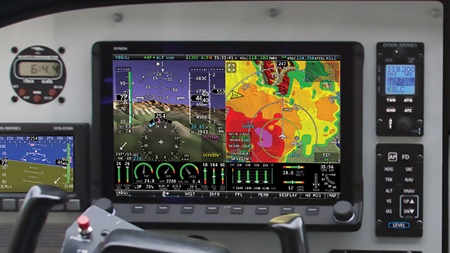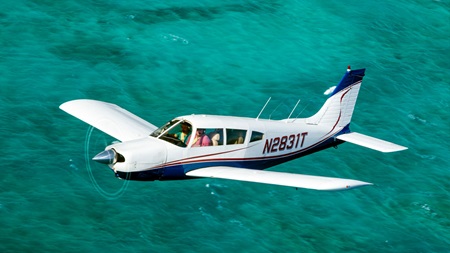Technically Advanced Airplanes
What they are and how they can help you become a commercial pilot

The term technically advanced airplane (TAA) has been in the aviation lexicon for several years. Even if you’ve never flown in one, you probably know that it involves electronic flight instrument systems (“glass”) as opposed to traditional analog (“steam” or “six pack”) gauges. The FAA originally described a TAA as an aircraft equipped with at least a “moving-map display, an IFR-approved GPS navigator, and an autopilot.” However, in the summer of 2018, the FAA specifically defined the term technically advanced airplane in the federal aviation regulations (61.129(j)). Combined with a change to the requirements for commercial pilot training, this change gives career-bound pilots access to more—potentially more modern, and less expensive—options for training aircraft.
According to FAR 61.1, a TAA is an airplane equipped with an electronically advanced avionics system. To further define what electronic display equipment is required in a TAA the FAA also created 61.129(j):
- (j)Technically advanced airplane. Unless otherwise authorized by the Administrator, a technically advanced airplane must be equipped with an electronically advanced avionics system that includes the following installed components:
 An electronic Primary Flight Display (PFD) that includes, at a minimum, an airspeed indicator, turn coordinator, attitude indicator, heading indicator, altimeter, and vertical speed indicator.
An electronic Primary Flight Display (PFD) that includes, at a minimum, an airspeed indicator, turn coordinator, attitude indicator, heading indicator, altimeter, and vertical speed indicator.- An electronic Multifunction Display (MFD) that includes, at a minimum, a moving map using Global Positioning System (GPS) navigation with the aircraft position displayed.
- A two axis autopilot integrated with the navigation and heading guidance system.
- The display elements described in paragraphs (j)(1) and (2) of this section must be continuously visible.
This definition does not specify from what source the PFD and MFD get their information, nor does it require the PFD and MFD to be separate physical units; they can be on a split-screen display or two independent screens within a single physical unit. However, a PFD typically includes the use of an attitude and heading reference system (AHRS), and the MFD facilitates GPS course navigation and moving map information. The autopilot may be integrated with the MFD, but it must be able to track a selected heading or course and hold a selected altitude, all displayed on the PFD and MFD. The definition is designed to be flexible to accommodate future technologies not yet developed or foreseen.
How can this new definition of TAA help you become a commercial pilot? Prior to the summer of 2018, if you wanted to obtain a commercial pilot certificate with a single-engine class rating, you needed (in addition to many other requirements under 61.129) 10 hours of training in an airplane that had retractable landing gear, flaps, and a controllable pitch propeller, or was turbine-powered. For an applicant seeking a single-engine seaplane rating, you needed 10 hours of training in a seaplane that had flaps and a controllable pitch propeller.
 Essentially, you needed 10 hours in a complex airplane (land or sea, depending on the class of airplane you intend to take the practical exam in). You also had the option to complete all or some of those 10 hours in a turbine-powered airplane.
Essentially, you needed 10 hours in a complex airplane (land or sea, depending on the class of airplane you intend to take the practical exam in). You also had the option to complete all or some of those 10 hours in a turbine-powered airplane.
However, increasing use of electronic flight instrument systems (“glass”) in general aviation, higher costs to operate and maintain general aviation aircraft with a retractable landing gear, and a reduction in the number of new general aviation aircraft models with retractable landing gear resulted in momentum to allow the use of TAA as a training option toward a commercial pilot certificate. FAR 61.129 now requires commercial pilot applicants for a single-engine airplane rating to log, among other requirements, “20 hours of training on the areas of operation listed in §61.127(b)(1) of this part that includes at least … 10 hours of training in a complex airplane, a turbine-powered airplane, or a technically advanced airplane (TAA) that meets the requirements of paragraph (j) of this section, or any combination thereof. The airplane must be appropriate to land or sea for the rating sought.
So, what does all of this mean?
- If you are seeking a commercial pilot certificate with airplane category single-engine class rating, you may use a complex, turbine powered, or TAA.
- You can use any combination of complex, turbine, or TAA, but only for the single-engine airplane rating.
- The FAA acknowledges that learning how to fly a complex aircraft requires different knowledge and skills than that of a TAA aircraft. However, what is important is the experience requirement. Most new aircraft have glass instruments, and some older aircraft are being retrofitted—this requires different risk management and proficiency skills specific to advanced avionics systems.
- Having the option to use TAAs, which are increasingly common, allows for lowered cost of finding and traveling to aircraft that can be used to complete your commercial pilot certificate. There is also the benefit of avoiding maintenance costs required for retractable gear aircraft.
- Even if a pilot has never completed training in a complex aircraft prior to earning the commercial pilot certificate, to act as PIC of a complex airplane an airman is still required to accomplish ground and flight training and receive an endorsement from an authorized instructor verifying competency. Similar to high performance and tailwheel endorsements, pilots operating complex aircraft need to receive sufficient experience and training to operate these aircraft proficiently and safely.
- The FAA has also removed the requirement to provide a complex or turbine powered airplane for the initial practical test in the Commercial and Flight Instructor ACS. The airplane just needs to accomplish all areas of operation and tasks required for the practical test and is accomplished in the appropriate category and class (i.e., land or sea) for the rating sought (FAR 61.45)